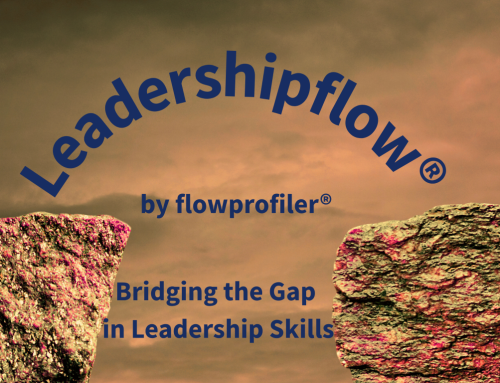Most professionals recognise that speaking up matters, yet many still waver between being heard and being feared. Research consistently links balanced assertiveness with higher engagement and lower stress, whereas aggression undermines trust and performance (Ames & Flynn, 2007; Carpenter & Mathews, 2016). This article clarifies the distinction, using flowprofiler®’s definition of Assertiveness:
heard and being feared. Research consistently links balanced assertiveness with higher engagement and lower stress, whereas aggression undermines trust and performance (Ames & Flynn, 2007; Carpenter & Mathews, 2016). This article clarifies the distinction, using flowprofiler®’s definition of Assertiveness:
“Certain in their actions, they are happy to articulate their strong opinions and views to others. They command respect and deliver messages with authority and impact. They arrive at decisions quickly and follow through on proposed actions. They take control and lead conversations through their powerful presence, influencing others to adopt their ideas.”
What Is Assertiveness?
Assertiveness is the confident expression of one’s needs, views and boundaries while respecting the rights and dignity of others (Gallo, 2012). Assertive communicators:
-
use clear, direct language without apology
-
invite dialogue and adjust when evidence warrants
-
project calm, open body language and steady tone
When leaders hit this “sweet spot”, teams report clearer goals, faster decisions and stronger psychological safety (Carpenter & Mathews, 2016).
What Is Aggression?
Aggression involves verbal or non-verbal behaviour intended to dominate, intimidate or harm (American Psychological Association [APA], n.d.). Aggressive communicators typically:
-
interrupt, ridicule or blame
-
focus on personal victory over problem resolution
-
trigger fear or defensiveness, silencing ideas
Aggressive climates correlate with higher turnover, absenteeism and burnout (Ashforth, 1997).
Key Differences at a Glance
| Feature | Assertive | Aggressive |
|---|---|---|
| Goal | Mutual clarity and respect | Personal control or dominance |
| Tone | Calm, firm, measured | Loud, hostile, sarcastic |
| Focus | Issue-centred | Person-centred, often attacking |
| Impact | Builds trust and engagement | Erodes morale and safety |
Practical Tips for Staying Assertive
-
Frame with “I” Language – “I need the draft by Tuesday” keeps the focus on the task, not the person (Knight, 2019).
-
State Intent + Respect – Combine firmness with consideration: “I disagree, and I’d like to hear your data before we decide.”
-
Check Non-Verbals – Open posture, level eye contact and a measured pace convey confidence without threat (Gallo, 2012).
-
Set Early Boundaries – Clarify meeting norms (e.g., no interruptions) to prevent escalation.
-
Pause Before Responding – A two-second breath can stop a rising emotional spike from tipping into aggression (Knight, 2019).
Workplace Scenarios
| Situation | Assertive Response | Aggressive Response |
|---|---|---|
| Interrupted in a Meeting | “Let me finish this point; then I’m keen to hear yours.” | “Stop cutting me off, you never listen!” |
| Missed Deadline | “The delay risks the launch. What support will ensure Tuesday delivery?” | “You’ve failed again; sort it out or else!” |
| Resource Clash | “Both projects matter. Let’s explore a staged schedule.” | “Mine takes priority, find your own budget.” |
Why Assertiveness Matters
Balanced assertiveness amplifies other leadership strengths and predicts higher performance ratings (Ames & Flynn, 2007). Conversely, even sporadic aggression damages relationships that are costly to rebuild (Ashforth, 1997). Professionals who master assertiveness lead discussions, not disputes, fulfilling flowprofiler®’s vision of influential, respected leadership.
performance ratings (Ames & Flynn, 2007). Conversely, even sporadic aggression damages relationships that are costly to rebuild (Ashforth, 1997). Professionals who master assertiveness lead discussions, not disputes, fulfilling flowprofiler®’s vision of influential, respected leadership.
Assertiveness and aggression can look similar at first glance, both appear forceful. Yet only assertiveness pairs decisiveness with respect, sustaining influence over time. By using the strategies above, you can ensure your voice is impactful without becoming overbearing, keeping your workplace productive, engaged and psychologically safe.
Reach out to us at hello@flowprofiler.com to explore how we can help your people develop assertiveness without aggression.
References
American Psychological Association. (n.d.). Aggression. In APA Dictionary of Psychology.
Ames, D. R., & Flynn, F. J. (2007). What breaks a leader: The curvilinear relation between assertiveness and leadership. Journal of Personality and Social Psychology, 92(2), 307–324.
Ashforth, B. E. (1997). Petty tyranny in organisations: A preliminary examination of antecedents and consequences. Canadian Journal of Administrative Sciences / Revue Canadienne des Sciences de l’Administration, 14(2), 126–140.
Carpenter, N. C., & Mathews, M. A. (2016). Leader assertiveness and follower outcomes: A meta-analysis. The Leadership Quarterly, 27(6), 802–817.
Gallo, A. (2012, August). How to be assertive (without losing yourself). Harvard Business Review, 90(8), 120–123.
Knight, R. (2019, July 3). How to handle difficult conversations at work. Harvard Business Review.




